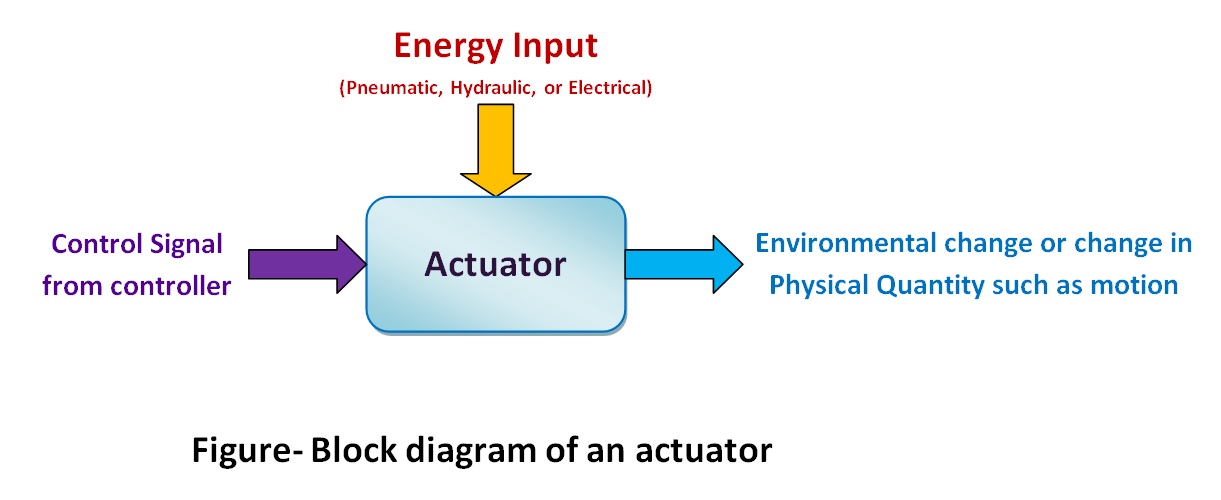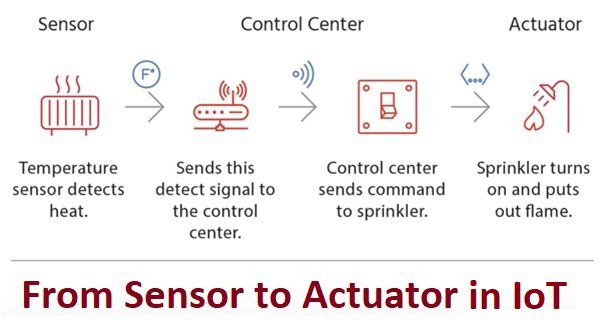Table of Contents
Introduction-
Although Sensors and actuators are often found in similar areas of applications i.e. in equipment and systems within industries and often interact, they are still two separate components. They are often said complementary to each other and work together to ensure that different assets and systems are operating effectively. In one line Sensors are detectors whereas actuators are mover. Both play an important role in process control units and conditional maintenance.
What are sensors?
Sensors are such devices which are used to convert physical quantities, events or characteristics into the electrical signals for the purpose of monitoring and controlling. So sensor takes input from environment and converts into electrical form then fed to the system or controller. Sensor works as an input device. For example- Thermocouple, photo cell, RTD, LVDT, strain gauge, Load cell etc. A block diagram for sensor is shown below-

What are Actuators?
On the other hand actuators are such devices which deliver physical quantity (like force or motion) to the environment by converting source energy according to control signal received that can be in electrical form. Here source energy can be pneumatic, hydraulic or electric type and motion produced (by actuator) can be either linear or rotary. Actuator acts as output device. For examples- different types of electric motor actuator, heaters, electro pneumatic actuator, electro-hydraulic actuator, magnetic actuator etc. A block diagram of actuator is shown below-





Difference between sensor and actuator
A comparison between sensor and actuators is shown in table-
| Sr. No. | Sensor | Actuator |
| 1 | Sensor converts physical quantities and characteristics into electrical signals. | Actuator converts electrical signals into physical action such as force and motion. |
| 2 | It acts as an input device in any control system and placed in input port | It acts as an output device in a control system and placed in output port |
| 3 | Sensor takes input from environment and senses surroundings condition. | Actuator takes input from output signal conditioning unit of system. |
| 4 | Sensor gives output to input signal conditioning unit of system to convert into electrical form. | It gives output to environment and makes impact on load to control parameters. |
| 5 | It gives information to the system about environment condition to monitor and control. | It accepts command from system to deliver physical action. |
| 6 | Sensors are often used to measure process pressure, temperature, fluid levels, flow, vibration, speed etc. | Actuators are often used to operate control valves, dampers, guide vanes, and to move objects from one place to another, to move conveyor belts in robotic arms movement etc.. |
| 7 | Sensor examples- Thermocouple, photo cell, RTD, LVDT, strain gauge, Load cell, hall sensors, differential flow meters, speed probes, PH meter etc | Actuator examples- motor actuator, servo motor, stepper motor, heaters, electro pneumatic actuator, electro-hydraulic actuator, magnetic actuator etc |
Sensors and actuators in Iot
The Internet of Things is defined as a paradigm in which objects equipped with sensor, actuator and processor communicate with each other to serve a meaningful purpose. IoT can also be seen simply as an interaction between the physical and digital worlds. Once a stand-alone device and application now has the ability to connect to the network via sensors, actuators, processors and transceivers.
Internet of Things (commonly known as IoT) is composed of several technology layers that enable ordinary things to share the data. They collect information over the Internet to ultimately deliver intelligence, autonomous actions and value which largely depend on the quality of the data itself. An IoT device is basically made up of a Physical object (things) + Controller (brain) + Networks (Internet) along with sensor and actuator. Sensor and Actuators are devices that enable interaction with the physical world in IoT technology. The following diagram shows how a sensor and actuators works together-





Here in basic form, sensors in the device sense the environment and fed to the controller, then based on set value, control signal is generated for the actuator to perform actions required to maintain set value. Such control signal is sent to actuator that moves or controls the mechanism or the system. It is to be noted that an actuator needs external energy to perform action.





A diagram for Sensor to actuator flow in IoT is shown. Sensors, actuators, computer servers, and the communication network form the core infrastructure of an IoT Framework. Data collection, handling, communication, and processing of the data are done under IoT technology. The IoT device collects a high amount of information from various sensors, and it is being decided through decision making which data is relevant for their condition and which places it is to be processed or stored, as well as which is desired communication level, while actuators enable the automation of the system for relevant information processing.
Click on the below links to read more about-
What are The types of actuator?
“Internet of things (IoT)” – Wikipedia link